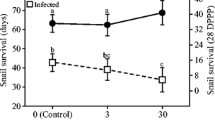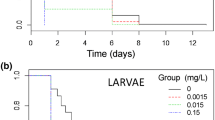Abstract
The faucet snail, Bithynia tentaculata, is an invasive snail that facilitates outbreaks of waterfowl disease in the Upper Mississippi River of the United States. In response, there is interest in identifying strategies that mitigate its population and spread. In this study we assessed the effects of a copper (Cu) molluscicide, EarthTec® QZ, at three concentrations (0, 0.1 and 0.6 mg/L Cu) on adult B. tentaculata and a coexisting native species, Physa gyrina. We found that in the 0.6 mg/L Cu treatment, ~ 68% of B. tentaculata snails remained alive after a 4-day exposure whereas all P. gyrina snails died. In contrast, a majority of both snail species remained alive and active after 4 days in the control and 0.1 mg/L Cu treatments. Although B. tentaculata demonstrated higher survivorship, it bioaccumulated more Cu than P. gyrina. Additionally, examination of B. tentaculata individuals revealed that females tended to exhibit higher mortality than males.



Similar content being viewed by others
References
Alonso A, Castro-Díez P (2008) What explains the invading success of the aquatic mud snail Potamopyrgus antipodarum (Hydrobiidae, Mollusca)? Hydrobiologia 614:107–116. https://doi.org/10.1007/s10750-008-9529-3
Arthur JW, Leonard EN (1970) Effects of copper on Gammarus pseudolimnaeus, Physa integra, and Campeloma decisum in soft water. J Fish Res Board Canada 27:1277–1283
Atli G, Grosell M (2016) Characterization and response of antioxidant systems in the tissues of the freshwater pond snail (Lymnaea stagnalis) during acute copper exposure. Aquat Toxicol 176:38–44. https://doi.org/10.1016/j.aquatox.2016.04.007
Carmosini N, Gillis R, Ismail A, Sandland GJ (2018) A pilot evaluation of the toxicity of EarthTec® QZ on invasive (Bithynia tentaculata) and native (Physa gyrina) snail species from the Upper Mississippi River. Bull Environ Contam Toxicol 101:428–433. https://doi.org/10.1007/s00128-018-2427-0
Das S, Khangarot BS (2011) Bioaccumulation of copper and toxic effects on feeding, growth, fecundity and development of pond snail Lymnaea luteola L. J Hazard Mater 185:295–305. https://doi.org/10.1016/j.jhazmat.2010.09.033
Désy JC, Archambault J-F, Pinel-Alloul B, Hubert J, Campbell PGC (2000) Relationships between total mercury in sediments and methyl mercury in the freshwater gastropod prosobranch Bithynia tentaculata in the St. Lawrence River, Quebec. Can J Fish Aquat Sci 57:164–173
EPA (2007) Aquatic life ambient freshwater quality criteria—copper, 2007 revision. U.S. Environmental Protection Agency, Office of Water, EPA-822-R-07-001, p. 204
Flessas C, Couillard Y, Pinel-Alloul B, St-Cyr L, Campbell PGC (2000) Metal concentrations in two freshwater gastropods (Mollusca) in the St. Lawrence River and relationships with environmental contamination. Can J Fish Aquat Sci 57:126–137
Foley HB et al (2019) Sex-specific stress tolerance, proteolysis, and lifespan in the invertebrate Tigriopus californicus. Exp Gerontol 119:146–156. https://doi.org/10.1016/j.exger.2019.02.006
Halmenschelager PT, da Rocha JBT (2019) Biochemical CuSO4 toxicity in Drosophila melanogaster depends on sex and developmental stage of exposure. Biol Trace Elem Res 189:574–585. https://doi.org/10.1007/s12011-018-1475-y
Hammond D, Ferris G (2019) Low doses of EarthTec QZ ionic copper used in effort to eradicate quagga mussels from an entire Pennsylvania lake. Manage Biol Invasions 10:500–516. https://doi.org/10.3391/mbi.2019.10.3.07
Kato S, Matsui T, Gatsogiannis C, Tanaka Y (2018) Molluscan hemocyanin: structure, evolution, and physiology. Biophys Rev 10:191–202. https://doi.org/10.1007/s12551-017-0349-4
Kelly PM, Cory JS (1987) Operculum closing as a defense against predatory leeches in four British freshwater prosobranch snails. Hydrobiologia 144:121–124
Khangarot BS, Das S (2010) Effects of copper on the egg development and hatching of a freshwater pulmonate snail Lymnaea luteola L. J Hazard Mater 179:665–675. https://doi.org/10.1016/j.jhazmat.2010.03.054
Kramarz PE, Mordarska A, Mroczka M (2014) Response of Tribolium castaneum to elevated copper concentrations is influenced by history of metal exposure, sex-specific defences, and infection by the parasite Steinernema feltiae. Ecotoxicology 23:757–766. https://doi.org/10.1007/s10646-014-1212-z
Lund K, Cattoor KB, Fieldseth E, Sweet J, McCartney MA (2017) Zebra mussel (Dreissena polymorpha) eradication efforts in Christmas Lake, Minnesota. Lake Reserv Manage 34:7–20. https://doi.org/10.1080/10402381.2017.1360417
Mills EL, Leach JH, Carlton JT, Secor CL (1993) Exotic species in the Great Lakes: a history of biotic crises and anthropogenic introductions. J Great Lakes Res 19:1–54
Naddafi R, Pettersson K, Eklöv P (2007) The effect of seasonal variation in selective feeding by zebra mussels (Dreissena polymorpha) on phytoplankton community composition. Freshw Biol 52:823–842. https://doi.org/10.1111/j.1365-2427.2007.01732.x
Ng TY, Pais NM, Wood CM (2011) Mechanisms of waterborne Cu toxicity to the pond snail Lymnaea stagnalis: physiology and Cu bioavailability. Ecotoxicol Environ Safe 74:1471–1479. https://doi.org/10.1016/j.ecoenv.2011.03.010
Perkins EJ, Griffin B, Hobbs M, Gollon J, Wolford L, Schlenk D (1997) Sexual differences in mortality and sublethal stress in channel catfish following a 10 week exposure to copper sulfate. Aquat Toxicol 37:327–339
Sandland GJ, Peirce JP (2021) Patterns of Sphaeridiotrema pseudoglobulus infection in sympatric and allopatric hosts (Bithynia tentaculata) originating from widely separated sites across the USA. Parasitol Res 120:187–195. https://doi.org/10.1007/s00436-020-06949-0
Sauer JS, Cole RA, Nissen JM (2007) Finding the exotic faucet snail (Bithynia tentaculata): investigation of waterbird die-offs on the Upper Mississippi River National Wildlife and Fish Refuge. U.S. Geological Survey Open-File Report 2007-1065, 3p
Suwannatrai K et al (2016) Differential protein expression in the hemolymph of Bithynia siamensis goniomphalos infected with Opisthorchis viverrini. PLoS Negl Trop D 10:e0005104. https://doi.org/10.1371/journal.pntd.0005104
Tricarico E, Junqueira AOR, Dudgeon D (2016) Alien species in aquatic environments: a selective comparison of coastal and inland waters in tropical and temperate latitudes. Aquat Conserv 26:872–891. https://doi.org/10.1002/aqc.2711
Van Kuik JA, Sijbesma RP, Kamerling JP, Vliegenthart JFG, Wood EJ (1987) Primary structure determination of seven novel N-linked carbohydrate changes derived from hemocyanin of Lymnaea stagnalis. Eur J Biochem 169:399–411
Watters A, Gerstenberger SL, Wong WH (2013) Effectiveness of EarthTec® for killing invasive quagga mussels (Dreissena rostriformis bugensis) and preventing their colonization in the Western United States. Biofouling 29:21–28. https://doi.org/10.1080/08927014.2012.744825
Weeks AM, De Jager NR, Haro RJ, Sandland GJ (2017) Spatial and temporal relationships between the invasive snail Bithynia tentaculata and submersed aquatic vegetation in Pool 8 of the Upper Mississippi River. River Res Appl 33:729–739. https://doi.org/10.1002/rra.3123
Wood AM, Haro CR, Haro RJ, Sandland GJ (2011) Effects of desiccation on two life stages of an invasive snail and its native cohabitant. Hydrobiologia 675:167–174. https://doi.org/10.1007/s10750-011-0814-1
Acknowledgements
Funding was provided by a Hardy W. Chan and Sons Chemistry Summer Undergraduate Research Fellowship awarded to A.R. Galbraith, the River Studies Center at UWL, and the UWL Department of Chemistry and Biochemistry. We thank Dr. D. Hammond (Earth Science Laboratories) for providing EarthTec QZ and Y. Ma (UWL) for assistance with snail collections.
Author information
Authors and Affiliations
Corresponding author
Ethics declarations
Conflict of interest
The authors declare that they have no conflict of interest.
Additional information
Publisher’s Note
Springer Nature remains neutral with regard to jurisdictional claims in published maps and institutional affiliations.
Rights and permissions
About this article
Cite this article
Galbraith, A.R., Sandland, G.J. & Carmosini, N. Evaluating the Life-History Responses of Adult Invasive (Bithynia tentaculata) and Native (Physa gyrina) Snails Exposed to a Cu-Based Pesticide (EarthTec® QZ). Bull Environ Contam Toxicol 107, 833–837 (2021). https://doi.org/10.1007/s00128-021-03340-2
Received:
Accepted:
Published:
Issue Date:
DOI: https://doi.org/10.1007/s00128-021-03340-2




